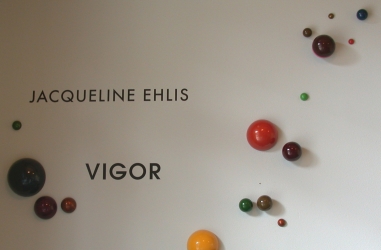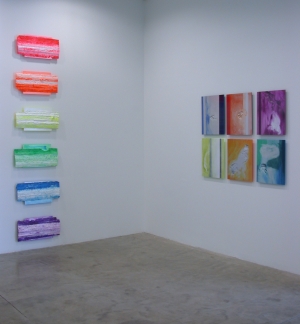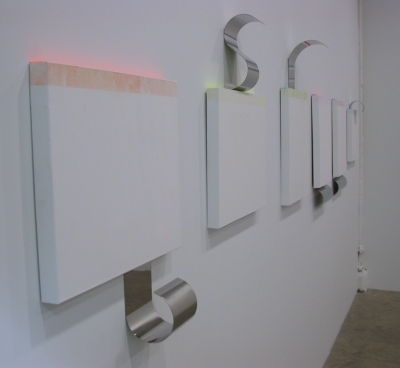
|
||
|
Portland art blog + news + exhibition reviews + galleries + contemporary northwest art
|
||
Jacqueline Ehlis at Savage
In her current show, entitled Vigor, Ehlis delves further into some of the explorations seen in her previous solo show at Savage's former Pearl District space in 2002. In the excellent DVD that was produced in conjunction with this exhibition, Ehlis poses the question of whether or not paint is a sophisticated enough medium in the 21st century. She eloquently answers this question by embracing a studio practice that is as rigorous conceptually as aesthetically. Ehlis, who is one of the most articulate artists I've encountered in Portland, is masterful at combining the depth of her intensive studio practice with more cerebral content in a way that never fails to deliver immediate visual pleasure. A former student of Dave Hickey at UNLV, Ehlis avoids dwelling on the more conceptual aspects of her work, although I find the depth of her formal investigations to be even more rewarding than her very likeable visual sensibility. The most extreme example of breaking apart the layers of painting occurs in Ehlis' series of planks, arrangements of freestanding slabs of chalky white paint with Plexiglas and wood, casually leaned against the wall. The separation of surface from grounds is complicated by the insertion of clear, and in some cases fluorescent pink and neon Plexiglas. If these are sculptural equivalents of painting, then the Plexiglas could be imagined as a stand-in for a number of things - pure color, gloss finish, the transformative effect of fluorescent pigment on the surrounding space, or perhaps even some sort of non-material aura. Works in the back gallery rely on this notion of a painting's aura. Large, airy canvases retain a very gestural touch through their use of layered washes, referencing the hand of the artist more overtly than any other work in the show. A series of sparse canvases with metal appendages make use of a literal aura due to the use of fluorescent paint, as well as the metaphorical aura referenced by titles like Lifted Love, Lifted Emotion and Lifted Universe. While the sculptural metallic sheets literally lift off the canvas, lifted also seems to refer to the notion of transcendence. The reflective metallic surfaces that extend into the gallery space serve as mirrors that capture the image of its surroundings, and sometimes the viewer, involving the artwork, viewer and white box in some sort of abstracted otherworldly communion. Posted by Katherine Bovee on June 07, 2005 at 17:12 | Comments (0) Comments Post a comment Thanks for signing in, . Now you can comment. (sign out)
(If you haven't left a comment here before, you may need to be approved by
the site owner before your comment will appear. Until then, it won't appear
on the entry. Thanks for waiting.)
|
| s p o n s o r s |
 |
 |
 |
 |
 |
 |
 |
 |
 |
 |
 |
 |
 |
 |

|
Site Design: Jennifer Armbrust | • | Site Development: Philippe Blanc & Katherine Bovee | |




